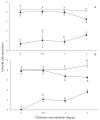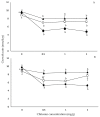Preliminary Study on the Use of Chitosan as an Eco-Friendly Alternative to Control Fusarium Growth and Mycotoxin Production on Maize and Wheat
- PMID: 30841490
- PMCID: PMC6470945
- DOI: 10.3390/pathogens8010029
Preliminary Study on the Use of Chitosan as an Eco-Friendly Alternative to Control Fusarium Growth and Mycotoxin Production on Maize and Wheat
Abstract
The objectives of the present study were to determine the combined effects of chitosan and water activity (aW) on growth and mycotoxin production in situ on the two most important Fusarium species (F. proliferatum and F. verticillioides) present on maize, and on F. graminearum, the main pathogen causing Fusarium head blight on wheat. Results showed that low-molecular-weight chitosan with more than 70% deacetylation at the lowest dose used (0.5 mg/g) was able to reduce deoxynivalenol (DON) and fumonisin (FBs) production on irradiated maize and wheat grains. Growth rates of F. graminearum also decreased at the lowest chitosan dose used (0.5 mg/g), while F. verticillioides and F. proliferatum growth rates were reduced at 0.98 aW at the highest chitosan dose used (2 mg/g). Since mycotoxins are unavoidable contaminants in food and feed chains, their presence needs to be reduced in order to minimize their effects on human and animal health and to diminish the annual market loss through rejected maize and wheat; in this scenario, pre- and post-harvest use of chitosan could be an important alternative.
Keywords: Fusarium; chitosan; deoxynivalenol; fumonisin; maize; wheat.
Conflict of interest statement
The authors declare no conflicts of interest.
Figures


References
-
- Marin S., Sanchis V., Ramos A.J., Vinas I., Magan N. Environmental factors, in vitro interactions, and niche overlap between Fusarium moniliforme, F. proliferatum, and F. graminearum, Aspergillus and Penicillium species from maize grain. Mycol. Res. 1998;102:831–837. doi: 10.1017/S0953756297005777. - DOI
-
- Marasas W.F.O., Kriek N.P.J., Wiggins V.M., Steyn P.S., Towers D.K., Hastie T.J. Incidence, geographic distribution, and toxigenicity of Fusarium species in South African corn. Phytopathology. 1979;69:1181–1185. doi: 10.1094/Phyto-69-1181. - DOI
LinkOut - more resources
Full Text Sources

